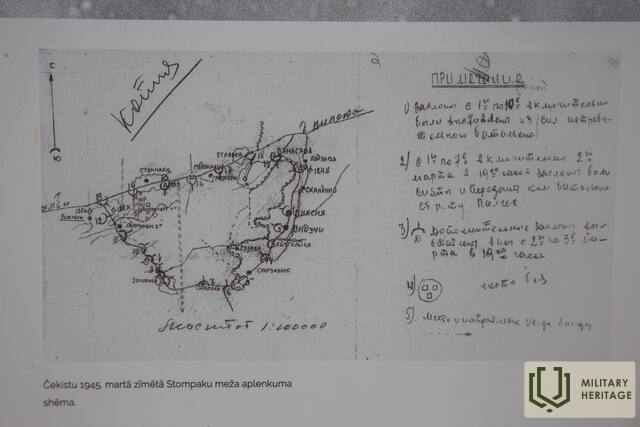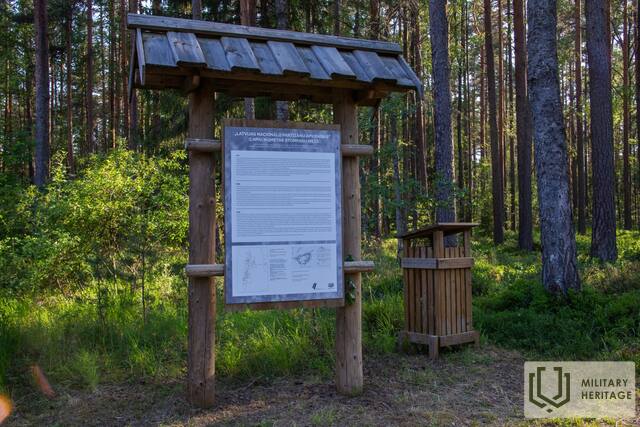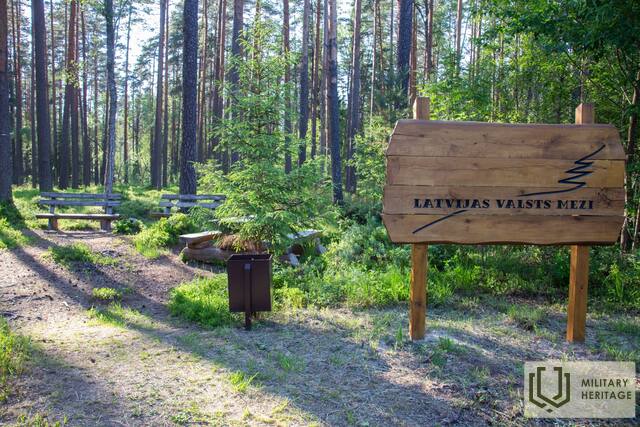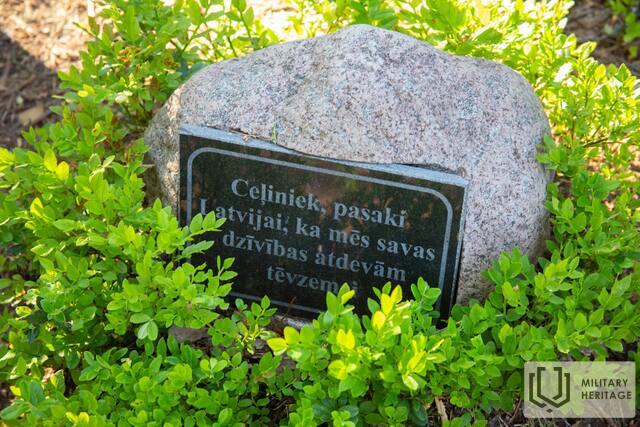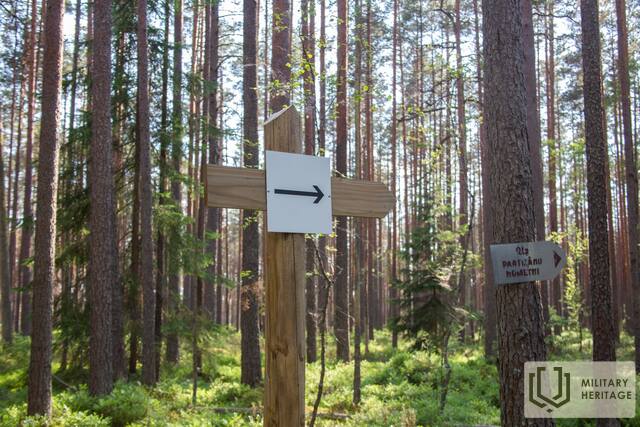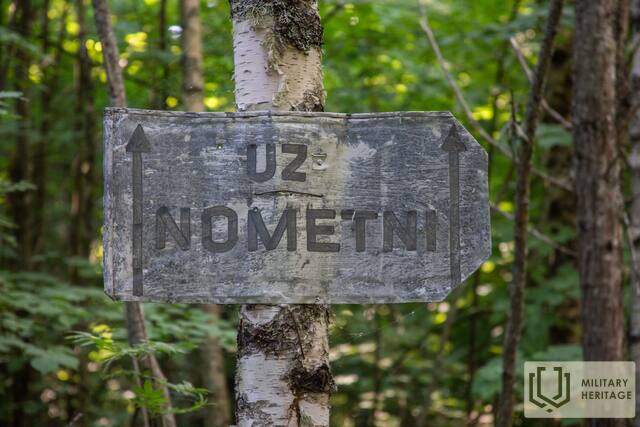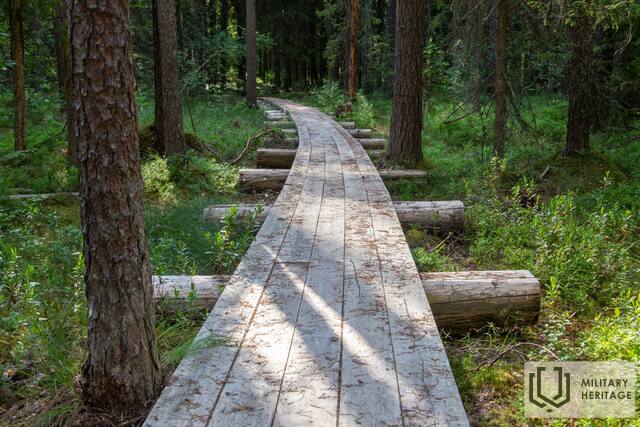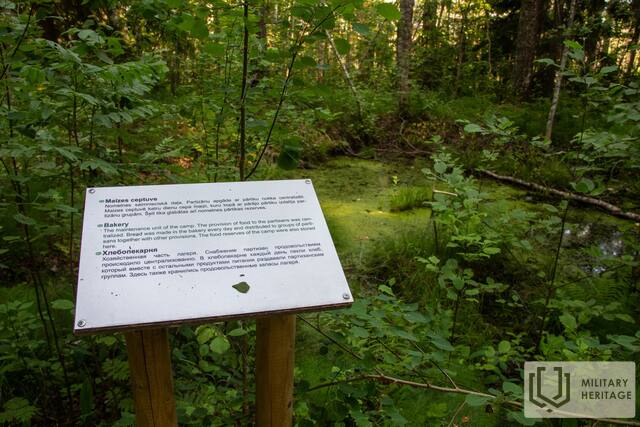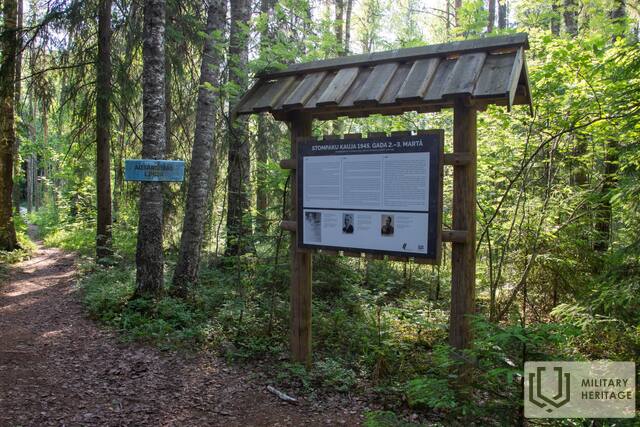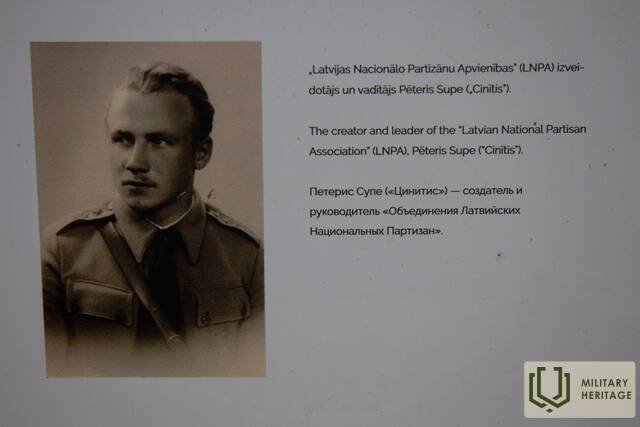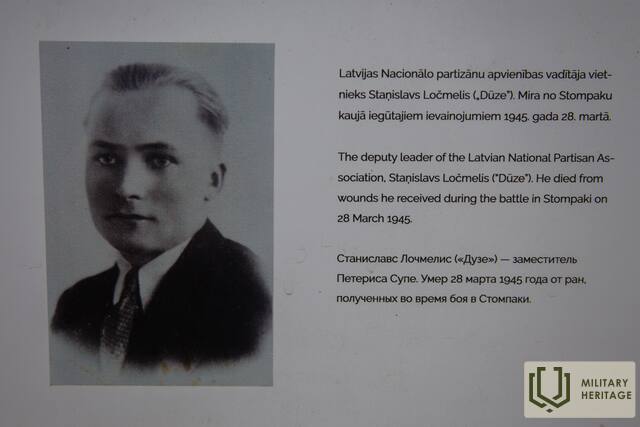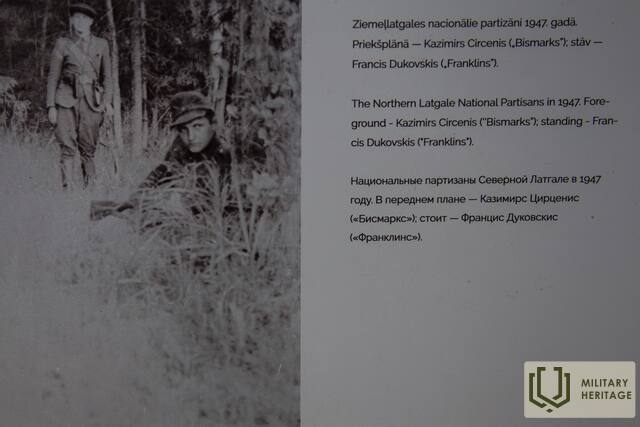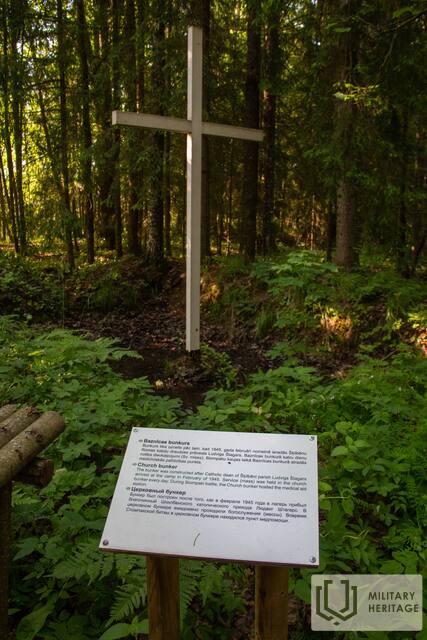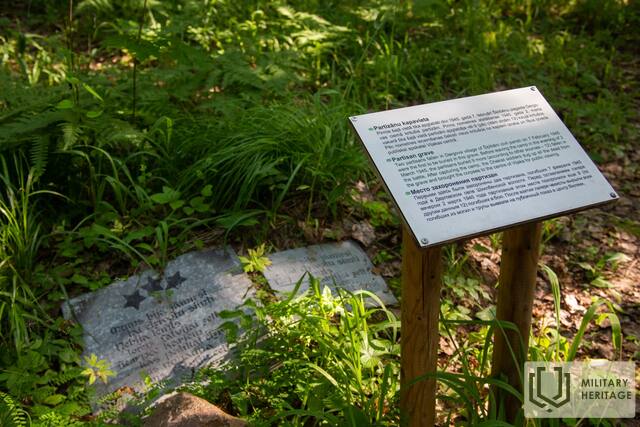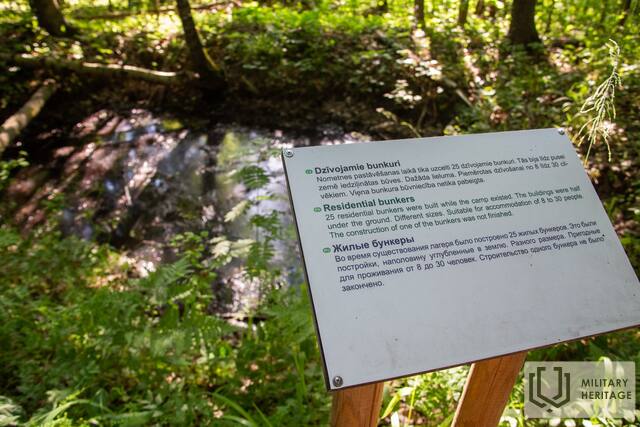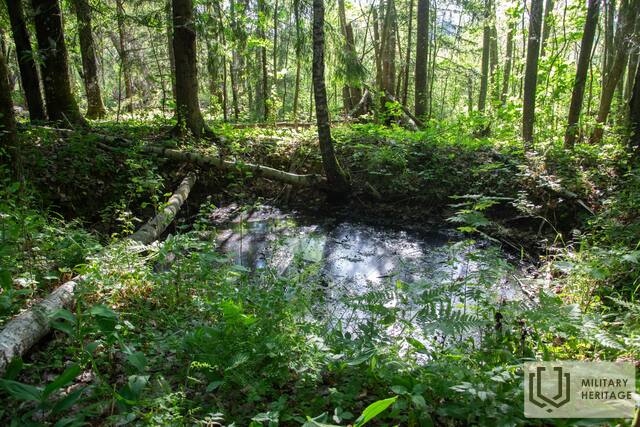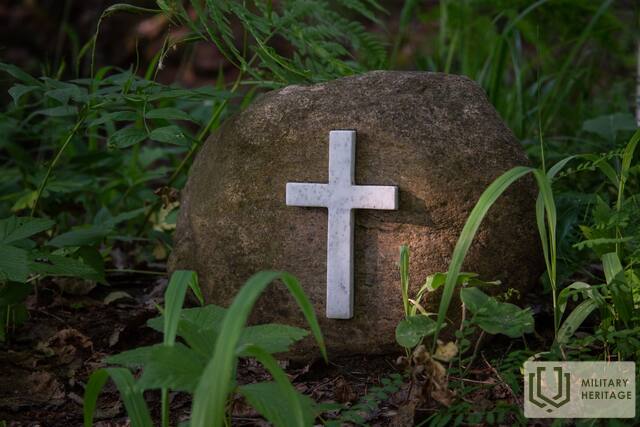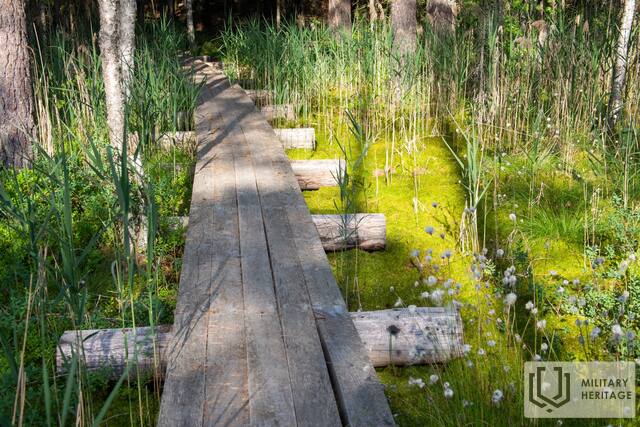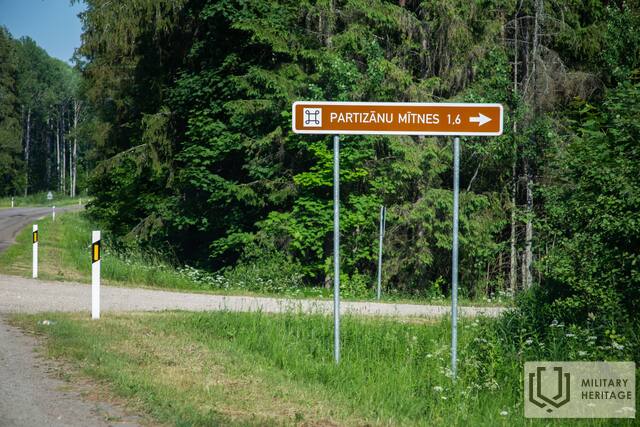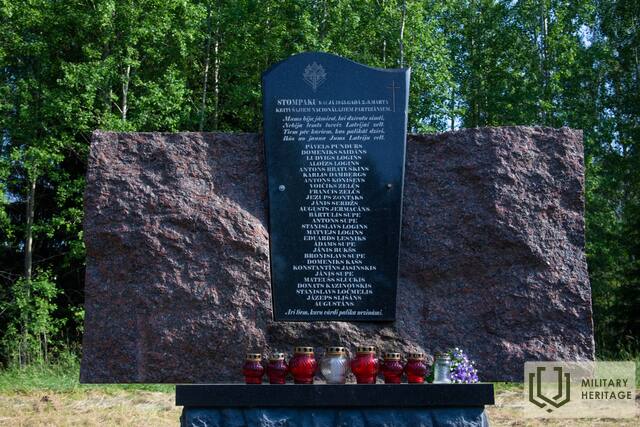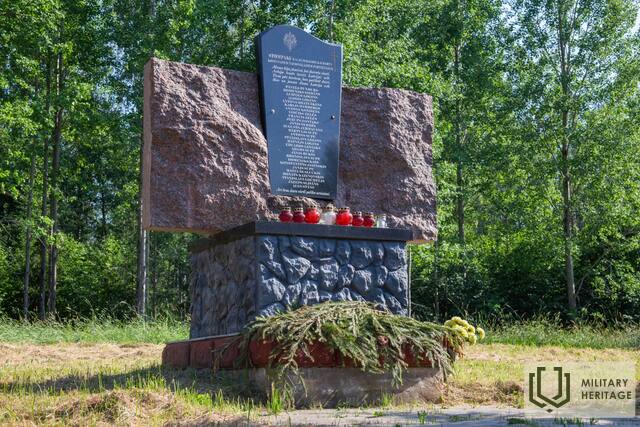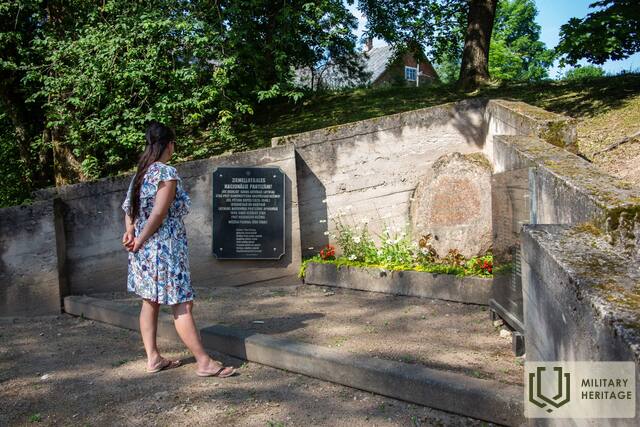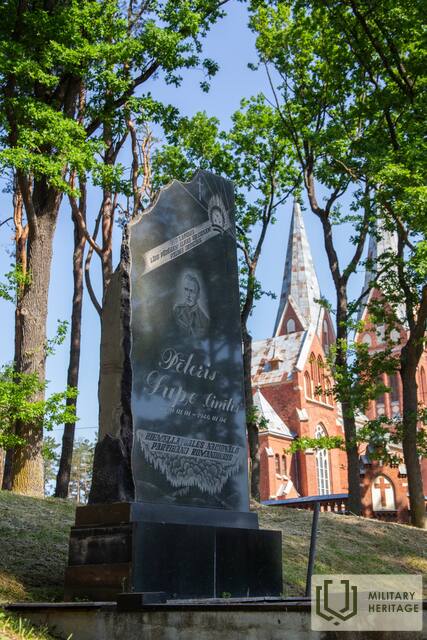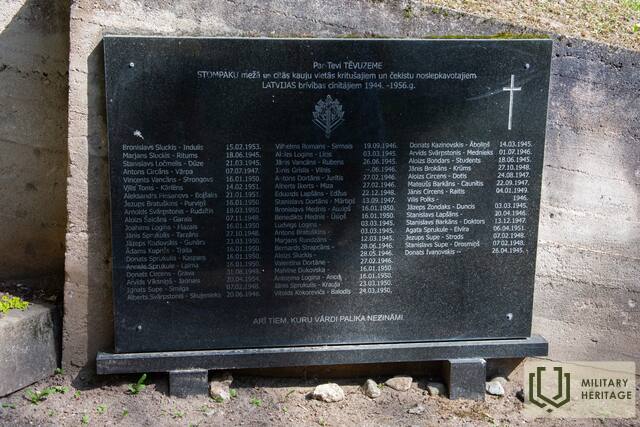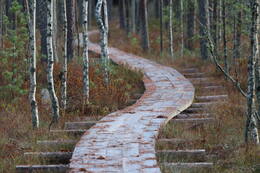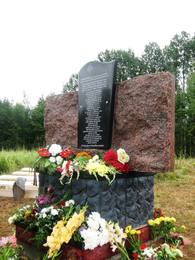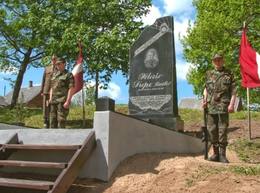Битва при Стомпаку
III Национальное движение сопротивления, “лесные братья”, II Вторая мировая война
2-3 марта 1945 года в Вилякской волости Абренского уезда (ныне Сусайская волость Вилякского уезда) произошло сражение при Стомпаку - крупнейшее сражение латышских национальных партизан против вооруженных формирований советского оккупационного режима в конце Вторая Мировая Война.
Вооруженное национальное движение сопротивления в графстве Абрене начало формироваться летом 1944 года, когда территория была повторно оккупирована Советским Союзом. Во избежание арестов и принудительной мобилизации в Красную Армию многие жители стали нелегально жить в лесах поодиночке или небольшими группами. В ночь на 2 октября 1944 года немцы высадили группу из 11 водолазов под кодовым названием «Лапландия» в районе Абрене. Его возглавили бывший главный агроном уезда Петерис Супе («Чинитис») и его заместитель Станиславс Лочмелис («Ас»), студент экономического факультета Латвийского университета. 10 декабря 1944 года они основали Латвийское национальное партизанское объединение (ЛНПА).
В начале января 1945 г. партизаны ЛНПА по приказу П. Супе стали собираться на болотах Стомпаку между Балви и Вилакой, где на нескольких болотных островах был разбит лагерь, считающийся самым крупным партизанский лагерь во всей Прибалтике. Его официальное название для партизан было «Островные приюты».
Лагерь, в котором проживало около 350 партизан, был атакован войсками НКВД из состава 143-го стрелкового полка численностью 483 человека. Бой длился со 2 марта у с 7.30 до 19.30, когда к утру 3 марта шум боя стих. Позиции обеих сторон находились всего в 70-80 метрах, и время от времени продолжались более длинные или короткие выстрелы. Используя сильный снегопад и ночное укрытие, большинству партизан удалось выйти из осады. В бою было убито или позже ранено 28 национальных партизан, но противник потерял 46 человек.
В Вилаке возле католической церкви со стороны улицы Парка установлен памятник с именами павших партизан.
Памятник 28 национальным партизанам, погибшим в битве при Стомпаку, был открыт на обочине шоссе Балви-Вилака 11 августа 2011 года.
Размеченная тропа ведет к поселениям национальных партизан в природном заповеднике «Стомпаку Пурви», который был открыт 2 марта 2019 года.
Дополнительные источники информации
Зигмарс Турчинскис. Битва при Стомпаку 2 марта 1945 года. SARGS.LV (12.04.2016): https://www.sargs.lv/lv/otrais-pasaules-kars/2016-04-12/stompaku-kauja-1945-gada-2-marta
Улдис Нейбургс. Мы должны были умереть, чтобы прожить сто лет. Битва при Стомпаку - 70. LA.LV (14.03.2015): https://www.la.lv/mums-bija-jamirst-lai-dzivotu-simtistompaku-kaujai-70
В мечтах дальний болотный край приходит...: [Книга о народных партизанах в Латгалии] / ев. авт. Ю.Кидзейс. -. Резекне: Издательство Латгальского культурного центра, 1997.
Связанная хронология
Связанные объекты
Деревянная пешеходная тропа, партизанский лагерь и мемориальное место на болоте Стомпаку
Болотный массив Стомпаку – особо охраняемая природная территория NATURA 2000 находится между Балви и Виляки. В восточной части болота проложена размеченная тропа протяженностью 1,5 км, пересекающая лес, а также небольшой участок высокого болота (деревянные мостки), доходящий до пяти болотных островов, на которых национальные партизаны построили жилые бункеры. По краям тропы установлены информационные стенды, рассказывающие как о здешних природных богатствах, так и об исторических событиях. Рядом с тропой есть зона отдыха. Тропу найти помогут указатели на дороге P35. В начале марта 1945 г. в лагере Стомпаку было основано одно из крупнейших национальных партизанских поселений в странах Балтии. Здесь проживало около 350-360 человек, в том числе 40-50 женщин. Начиная с января 1945 г. национальные партизаны регулярно нападали на военных и сторонников оккупационного режима. В лагере была пекарня, церковный бункер и 25 жилых бункеров – наполовину вкопанных в землю построек, где могли жить 8-30 человек.
Места расположения бункеров все еще видны и сегодня. 2-3-го марта 1945 г. здесь состоялась битва при Стомпаку – крупнейшее сражение в истории Латвийской национальной партизанской борьбы. В состав сил, воюющих против партизан, входили 2-й и 3-й стрелковые батальоны 143-го стрелкового полка 5-й стрелковой дивизии НКВД, стрелковые части (вооруженные пистолетами-пулеметами), роты минометчиков, разведывательные и саперные подразделения, а также бойцы так называемых истребительных батальонов – всего около 483 солдат.
Памятник участникам движения сопротивления в Стомпакисе
Находится в 15 км от Балви в направлении Вилякаса, справа от дороги.
Виден мемориал.
Открыт мемориал участникам движения сопротивления, посвященный памяти национальных партизан Петераса Супеса, павших в боях 2 и 3 марта 1945 г., на обочине шоссе Балва-Виляка напротив Стомпакского болота. 11 августа 2011 года, в день памяти борцов за свободу Латвии. В конце июля в основание памятника была заложена капсула с посланием будущим поколениям. В капсулу помещен документ с именами 28 национальных партизан, павших в боях 2 и 3 марта 1945 года.
"В феврале 1945 года на островах болота Стомпаку, которые в народе стали называть островами болота Стомпаку, в 2 км от шоссе Балву - Виляка, был создан крупнейший в Латвии национальный партизанский лагерь, где проживало 360 человек в 22 землянках.Среди них несколько легионеров,которые при отступлении легионной дивизии остались со всем оружием в доме отца.Для уничтожения партизан 2 марта 1945 года бойцы двух батальонов чешских войск атаковали землянки вместе с эсминцами, которые также имели на вооружении четыре миномета.Бои шли весь день, партизаны упорно сопротивлялись, а наступающие понесли большие потери, так что не смогли захватить лагерь и уничтожить партизан.28 жителей с. Болото Стомпаку тоже пало или погибло после тяжелого ранения в бою. На следующую ночь партизаны с боем прорвали осаду лагеря и ушли непобежденными" - так считает участник движения национального сопротивления наградного отдела пишет о битве в Стомпаку председатель комиссии по делу Зигфридс Беркис.
Памятник командиру Северо-восточных национальных партизан Петерису Супу - «Чинитис»
В память о национальном командире партизан Петерасе Супесе 28 мая 2005 г. в Вилакасе был открыт памятник, посвященный ему. Он расположен возле Вилякской католической церкви, на краю вырытых во время войны траншей, где чекисты хоронили расстрелянных национальных партизан. Под памятником П. Супему помещена капсула с именами 386 павших национальных партизан, описаниями боев и материалами о партизанском командире. Слова, высеченные в камне: «Я оставался верным тебе, Латвия, до последнего вздоха».
Памятник создал Петерис Кравалис.
Рядом с ним мемориальное место в Стомпакском лесу и других местах боев борцов за свободу Латвии, павших и убитых чекистами в 1944-1956 годах.
20 июня 2008 г. на правой стене была обнаружена гранитная доска с именами 55 павших партизан, расположенными в три столбца.
Памятник установлен на том месте, где когда-то коммунистические оккупационные власти выставляли останки убитых партизан для устрашения остального населения.
На соседней табличке выгравированы слова благодарности Петерису Супе и стихотворение Брониславы Мартужевой:
«Вставай, Питер Супе,
Душа, в бой!
Сегодня Твоя кровавая жертва,
Восстал в нации.
Уходи, чтобы жить вечно
В силе и бодрости молодых,
Заворачивается, трепещет, складывается
В поднимающемся флаге!»
Музей Вилака. Выставки о военном наследии в районе Виляки
Музей Виляки работает в двух зданиях – католическом приходском доме, построенном в 1913 году, который является важным объектом культурного наследия города, и другом здании музея – бывшем монастыре монахов-капуцинов, подвалы которого тесно связаны с национальным партизанским движением в Стомпаки и советской ЧК. По воспоминаниям местных жителей, в этих подвалах содержались и подвергались пыткам люди. В старом здании музея размещено несколько экспозиций, одна из которых посвящена освободительным боям 1920 года в Северной Латгалии, а вторая – событиям Второй мировой войны – еврейскому Холокосту в Виляке и информации о расстрелянных семьях. Более подробная информация о каждой семье доступна по ее адресу.
Экспозицию дополняет информация о национальном партизанском движении в Стомпаки – различные свидетельства, фотографии и предметы. Посетители могут узнать о военных объектах наследия в Виляке и ее окрестностях, таких как Памятник борцам за свободу в Яшкове, который был снесен в советское время и восстановлен в 1990 году, и стела, посвященная кавалерам ордена Лачплесиса. В экспозицию музея включен звук самолетов Второй мировой войны, поскольку немецкий аэродром Люфтваффе находился недалеко от Виляки. Музей дает возможность увидеть некоторые воспоминания о событиях Второй мировой войны в Виляке, а также получить информацию о немецком лагере для военнопленных в Рачи
Связанные истории
Петерис Супе - инициатор создания Латвийской национальной партизанской ассоциации.
С 1944 по 1946 год Петер Супем сумел объединить разбросанные по лесам национальные партизанские отряды в организованное движение, которое в течение нескольких лет после Второй мировой войны боролось против оккупации Латвии в районе Абрене. Петерис Супе по прозвищу «Чинитис» был одним из самых выдающихся организаторов и руководителей национального партизанского движения в Северной Латгалии.
Лесная дочь Домичелла Пундуре (Люсия)
Домичелле Пундуре 90 лет. 3 мая 2018 года в Рижском замке она была награждена орденом Виестура из рук президента Раймонда Вейониса за особые заслуги в движении национального сопротивления и в защите независимости страны. Домичелла Пундуре остается последним свидетелем битвы на болоте Стомпаку.




